1、Matplotlib Multiplots
在本章中,我们将学习如何在同一画布上创建多个子图。
subplot()函数返回给定网格位置的axes对象。此函数的签名是
plt.subplot(subplot(nrows, ncols, index)
在当前图中,该函数创建并返回一个Axes对象,在ncolsaxes的nrows网格的位置索引处。索引从1到nrows * ncols,以行主顺序递增。如果nrows,ncols和index都小于10。索引也可以作为单个,连接,三个数字给出。
例如,subplot(2, 3, 3)和subplot(233)都在当前图形的右上角创建一个轴,占据图形高度的一半和图形宽度的三分之一。
创建子图将删除任何与其重叠的预先存在的子图,而不是共享边界。
参考以下示例代码:
import matplotlib.pyplot as plt
# 显示中文设置...
plt.rcParams['font.sans-serif'] = ['SimHei'] # 步骤一(替换sans-serif字体)
plt.rcParams['axes.unicode_minus'] = False # 步骤二(解决坐标轴负数的负号显示问题)原文出自【立地货】,商业转载请联系作者获得授权,非商业请保留原文链接# plot a line, implicitly creating a subplot(111)
plt.plot([1,2,3])# now create a subplot which represents the top plot of a grid with 2 rows and 1 column.#Since this subplot will overlap the first, the plot (and its axes) previously created, will be removed
plt.subplot(211)
plt.plot(range(12))
plt.subplot(212, facecolor='y') # creates 2nd subplot with yellow background
plt.plot(range(12))
plt.show()
执行上面示例代码,得到以下结果:
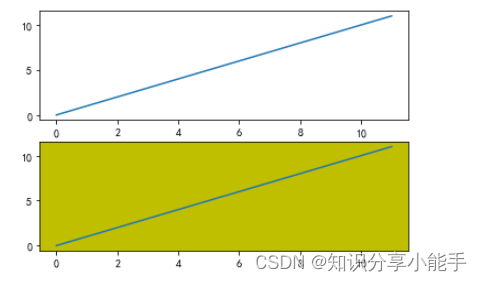
figure类的add_subplot()函数不会覆盖现有的图,参考以下代码
import matplotlib.pyplot as plt
# 显示中文设置...
plt.rcParams['font.sans-serif'] = ['SimHei'] # 步骤一(替换sans-serif字体)
plt.rcParams['axes.unicode_minus'] = False # 步骤二(解决坐标轴负数的负号显示问题)
fig = plt.figure()
ax1 = fig.add_subplot(111)
ax1.plot([1,2,3])
ax2 = fig.add_subplot(221, facecolor='y')
ax2.plot([1,2,3])
plt.show()
运行结果
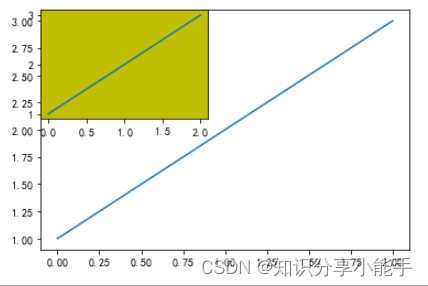
可以通过在同一图形画布中添加另一个轴对象来在同一图中添加插入图。参考以下实现代码
import matplotlib.pyplot as plt
import numpy as np
import math# 显示中文设置...
plt.rcParams['font.sans-serif'] = ['SimHei'] # 步骤一(替换sans-serif字体)
plt.rcParams['axes.unicode_minus'] = False # 步骤二(解决坐标轴负数的负号显示问题)
x = np.arange(0, math.pi*2, 0.05)
fig=plt.figure()
axes1 = fig.add_axes([0.1, 0.1, 0.8, 0.8]) # main axes
axes2 = fig.add_axes([0.55, 0.55, 0.3, 0.3]) # inset axes
y = np.sin(x)
axes1.plot(x, y, 'b')
axes2.plot(x,np.cos(x),'r')
axes1.set_title('正弦')
axes2.set_title("余弦")
plt.show()
运行结果
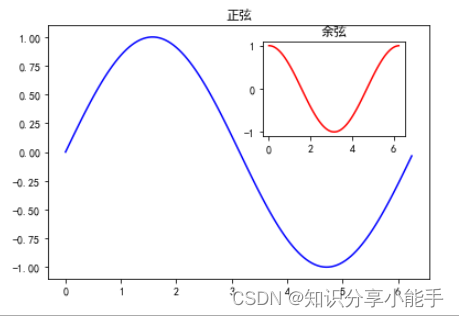
2、Matplotlib subplots()函数
Matplotlib的pyplot API有一个称为subplots()的便捷函数,它充当实用程序包装器,并在单个调用中帮助创建子图的公共布局,包括封闭的图形对象。函数的原型如下:
plt.subplots(nrows, ncols)
此函数的两个整数参数指定子图网格的行数和列数。该函数返回一个图形对象和一个包含等于nrows * ncols的轴对象的元组。每个轴对象都可通过索引访问。在这里,我们创建一个2行2列的子图,并在每个子图中显示4个不同的图。
参考以下实现代码:
import matplotlib.pyplot as plt
import numpy as np
import math
# 显示中文设置...
plt.rcParams['font.sans-serif'] = ['SimHei'] # 步骤一(替换sans-serif字体)
plt.rcParams['axes.unicode_minus'] = False # 步骤二(解决坐标轴负数的负号显示问题)
fig,a = plt.subplots(2,2)
x = np.arange(1,5)
a[0][0].plot(x,x*x)
a[0][0].set_title('平方')
a[0][1].plot(x,np.sqrt(x))
a[0][1].set_title('平方根')
a[1][0].plot(x,np.exp(x))
a[1][0].set_title('指数')
a[1][1].plot(x,np.log10(x))
a[1][1].set_title('log')
plt.show()
执行上面示例代码,得到以下结果
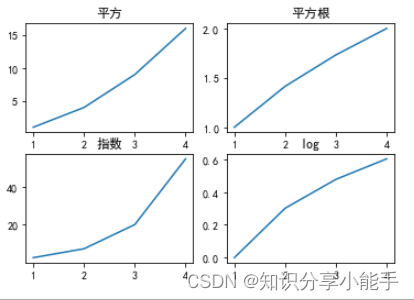
3、Matplotlib subplot2grid()函数
Matplotlib subplot2grid()函数在网格的特定位置创建轴对象提供了更大的灵活性。它还允许轴对象跨越多个行或列。
plt.subplot2grid(shape, location, rowspan, colspan)
在下面的示例中,图形对象的3X3网格填充了行和列跨度中不同大小的轴对象,每个对象显示不同的图。
参考以下示例代码:
import matplotlib.pyplot as plt
import numpy as np
import math
# 显示中文设置...
plt.rcParams['font.sans-serif'] = ['SimHei'] # 步骤一(替换sans-serif字体)
plt.rcParams['axes.unicode_minus'] = False # 步骤二(解决坐标轴负数的负号显示问题)
a1 = plt.subplot2grid((3,3),(0,0),colspan = 2)
a2 = plt.subplot2grid((3,3),(0,2), rowspan = 3)
a3 = plt.subplot2grid((3,3),(1,0),rowspan = 2, colspan = 2)
x = np.arange(1,10)
a2.plot(x, x*x)
a2.set_title('平方')
a1.plot(x, np.exp(x))
a1.set_title('指数')
a3.plot(x, np.log(x))
a3.set_title('log')
plt.tight_layout()
plt.show()
执行上面示例代码,得到以下结果
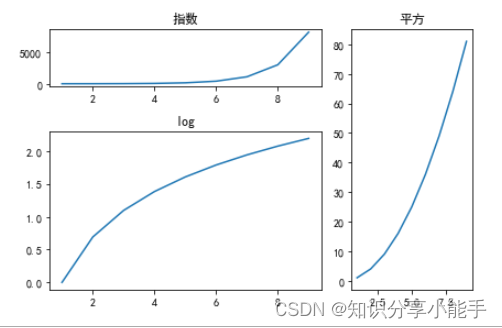


——day35)
![[大模型]MiniCPM-2B-chat WebDemo部署](http://pic.xiahunao.cn/[大模型]MiniCPM-2B-chat WebDemo部署)















